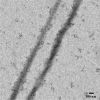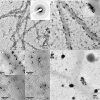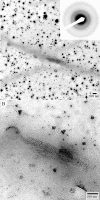Amelogenin-collagen interactions regulate calcium phosphate mineralization in vitro
- PMID: 20404336
- PMCID: PMC2885206
- DOI: 10.1074/jbc.M109.079939
Amelogenin-collagen interactions regulate calcium phosphate mineralization in vitro
Abstract
Collagen and amelogenin are two major extracellular organic matrix proteins of dentin and enamel, the mineralized tissues comprising a tooth crown. They both are present at the dentin-enamel boundary (DEB), a remarkably robust interface holding dentin and enamel together. It is believed that interactions of dentin and enamel protein assemblies regulate growth and structural organization of mineral crystals at the DEB, leading to a continuum at the molecular level between dentin and enamel organic and mineral phases. To gain insight into the mechanisms of the DEB formation and structural basis of its mechanical resiliency we have studied the interactions between collagen fibrils, amelogenin assemblies, and forming mineral in vitro, using electron microscopy. Our data indicate that collagen fibrils guide assembly of amelogenin into elongated chain or filament-like structures oriented along the long axes of the fibrils. We also show that the interactions between collagen fibrils and amelogenin-calcium phosphate mineral complexes lead to oriented deposition of elongated amorphous mineral particles along the fibril axes, triggering mineralization of the bulk of collagen fibril. The resulting structure was similar to the mineralized collagen fibrils found at the DEB, with arrays of smaller well organized crystals inside the collagen fibrils and bundles of larger crystals on the outside of the fibrils. These data suggest that interactions between collagen and amelogenin might play an important role in the formation of the DEB providing structural continuity between dentin and enamel.
Figures








Similar articles
-
Enhancing Collagen Mineralization with Amelogenin Peptide: Towards the Restoration of Dentin.ACS Biomater Sci Eng. 2020 Apr 13;6(4):2251-2262. doi: 10.1021/acsbiomaterials.9b01774. Epub 2020 Feb 21. ACS Biomater Sci Eng. 2020. PMID: 33313393 Free PMC article.
-
Biomineralization of Enamel and Dentin Mediated by Matrix Proteins.J Dent Res. 2021 Sep;100(10):1020-1029. doi: 10.1177/00220345211018405. Epub 2021 Jun 21. J Dent Res. 2021. PMID: 34151644 Free PMC article. Review.
-
Role of 20-kDa amelogenin (P148) phosphorylation in calcium phosphate formation in vitro.J Biol Chem. 2009 Jul 10;284(28):18972-9. doi: 10.1074/jbc.M109.020370. Epub 2009 May 14. J Biol Chem. 2009. PMID: 19443653 Free PMC article.
-
Possible role of DMP1 in dentin mineralization.J Struct Biol. 2011 Apr;174(1):100-6. doi: 10.1016/j.jsb.2010.11.013. Epub 2010 Nov 23. J Struct Biol. 2011. PMID: 21081166 Free PMC article.
-
Amelogenin supra-molecular assembly in vitro compared with the architecture of the forming enamel matrix.Cells Tissues Organs. 2005;181(3-4):202-18. doi: 10.1159/000091382. Cells Tissues Organs. 2005. PMID: 16612086 Review.
Cited by
-
Synthesis of bone-like nanocomposites using multiphosphorylated peptides.Acta Biomater. 2014 May;10(5):2241-9. doi: 10.1016/j.actbio.2014.01.007. Epub 2014 Jan 13. Acta Biomater. 2014. PMID: 24434535 Free PMC article.
-
Cryogenic transmission electron microscopy study of amelogenin self-assembly at different pH.Cells Tissues Organs. 2011;194(2-4):166-70. doi: 10.1159/000324250. Epub 2011 May 20. Cells Tissues Organs. 2011. PMID: 21597263 Free PMC article.
-
Hierarchical self-assembly of amelogenin and the regulation of biomineralization at the nanoscale.Proc Natl Acad Sci U S A. 2011 Aug 23;108(34):14097-102. doi: 10.1073/pnas.1106228108. Epub 2011 Aug 8. Proc Natl Acad Sci U S A. 2011. PMID: 21825148 Free PMC article.
-
Comparative Sample Preparation Using Focused Ion Beam and Ultramicrotomy of Human Dental Enamel and Dentine for Multimicroscopic Imaging at Micro- and Nanoscale.Materials (Basel). 2022 Apr 24;15(9):3084. doi: 10.3390/ma15093084. Materials (Basel). 2022. PMID: 35591421 Free PMC article.
-
Regulation of calcium phosphate formation by amelogenins under physiological conditions.Eur J Oral Sci. 2011 Dec;119 Suppl 1(Suppl 1):103-11. doi: 10.1111/j.1600-0722.2011.00911.x. Eur J Oral Sci. 2011. PMID: 22243235 Free PMC article.
References
-
- Nanci A. (2007) Ten Cate's Oral Histology: Development, Structure, and Function, Mosby, St. Louis, MO
-
- Weiner S., Wagner H. D. (1998) Annu. Rev. Materials Sci. 28, 271–298
-
- Landis W. J., Hodgens K. J., Arena J., Song M. J., McEwen B. F. (1996) Microsc. Res. Tech. 33, 192–202 - PubMed
-
- Weiner S., Traub W. (1992) FASEB J. 6, 879–885 - PubMed
-
- Brodsky B., Ramshaw J. A. M. (1997) Matrix Biol. 15, 545–554 - PubMed
Publication types
MeSH terms
Substances
Grants and funding
LinkOut - more resources
Full Text Sources
Molecular Biology Databases

